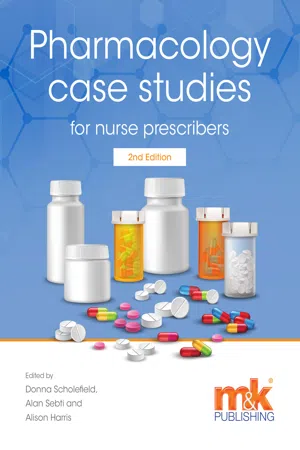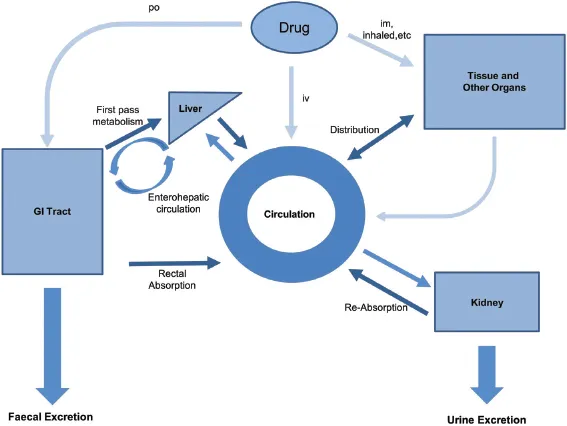
- English
- ePUB (mobile friendly)
- Available on iOS & Android
Pharmacology Case Studies for Nurse Prescribers
About This Book
This new edition of the popular Pharmacology case studies for nurse prescribers has been thoroughly revised in the light of the latest research and guidance from NICE, the British National Formulary (BNF), the Royal Pharmaceutical Society, the Nursing and Midwifery Council and the Royal College of Nursing. While the first edition was aimed at students undertaking the non-medical prescribing modules, this updated text has broadened its scope and is relevant to all trainee and qualified nurse prescribers. There are new and additional chapters on pregnancy and breastfeeding, sexual health and contraception, and prescribing for frailty syndrome in the elderly. The latest developments in pharmacology (such as the emergence of biosimilar drugs) are included in the text; and all the chapters from the first edition have been revised and updated by expert healthcare practitioners.Meanwhile, the practical approach and helpful features that made the first edition so popular remain unchanged. The authors offer a basic introduction to pharmacological concepts, embedded in specific conditions, through case studies and self-assessment questions. By utilising a case study approach, they enable the reader to link pharmacological concepts with clinical practice. Reading this book, and carrying out the numerous self-assessment activities, will give the reader an appreciation of the value of having a sound pharmacological knowledge base in order to deliver safe practice, effective prescribing and improved patient care.Praise for the first edition: 'A useful and practical accompaniment for those studying nurse prescribing, this textbook is also a valuable resource for practitioners qualified in this extended role and those who prescribe and administer medications daily.'Valerie McGurk, Practice Development Nurse, Nursing Management'This book is a comprehensive collection of case studies on a number of conditions, from heart failure to eye problems.'Lynda Gibbons, Registered Advanced Nurse Practitioner, Emergency Nurse
Frequently asked questions
Information
1
How the body affects drugs
This chapter:




Introduction

Blood drug concentration
Pharmacokinetic parameters
| Pharmacokinetic parameter | Definition |
| Cmax | Maximum drug concentration after absorption |
| Tmax | Time needed to achieve maximum drug concentration |
| Ke | Drug elimination rate constant |
| Cl | Systemic clearance of drug from the body |
| t1/2 | Half-life of drug – time taken for 50% of drug to be eliminated from the body |
| F | Bioavailability of a drug – a measure of both the rate and extent of drug absorption into blood circulation. In day-to-day use, bioavailability is generally used to describe the extent, i.e. the proportion (or percentage) of drug absorbed into blood circulation. |
| Vd | Volume of distribution – an indicator of the extent of drug distribution into tissues. This is the theoretical volume that would contain the total amount of drug in the body at the same concentration as it is in the blood. |
Drug formulations and administration routes
Drug absorption

Transportation of drugs
Passive diffusion
Active transport
Endocytosis
Factors affecting drug absorption and drug bioavailability
| Factors | Influence on drug absorption | Example |
| Blood flow to the absorption site | •Abundant blood flow to the absorption site will facilitate drug absorption. | •Digoxin bioavailability is increased when gastrointestinal blood flow is increased. Another example is that increased skin temperature increases... |
Table of contents
- Title Page
- Copyright
- Contents
- Acknowledgements
- List of contributors
- List of reviewers
- Introduction
- 1. How the body affects drugs
- 2. How drugs affect the body
- 3. Types of adverse drug reactions and interactions
- 4. Understanding and using the British National Formulary
- 5. Adherence
- 6. Pharmacological case studies: Pregnancy and breastfeeding
- 7. Pharmacological case studies: Children
- 8. Pharmacological case studies: Sexual health and contraception
- 9. Pharmacological case studies: Stable angina
- 10. Pharmacological case studies: Hypertension
- 11. Pharmacological case studies: Heart failure
- 12. Pharmacological case studies: Chronic obstructive pulmonary disease (COPD)
- 13. Pharmacological case studies: Neurological disorders
- 14. Pharmacological case studies: Gastrointestinal disorders
- 15. Pharmacological case studies: Urinary incontinence in adults
- 16. Pharmacological case studies: Diabetes
- 17. Pharmacological case studies: Mental health illness
- 18. Pharmacological case studies: Eye problems
- 19. Pharmacological case studies: Complex health needs and polypharmacy
- 20. Pharmacological case studies: Frailty
- 21. Pharmacological case studies: Palliative care
- 22. Insights into professional prescribing
- Glossary
- List of abbreviations
- Index